LAGOS STATE GOVERNMENT MINISTRY OF EDUCATIONUNIFIED SCHEMES
OF WORK FOR PRIMARY SCHOOLS | | Physical and Health Education Scheme of Work for Primary/Basic 2 | | | CLASS | Primary/Basic 2 | | | SUBJECT | Physical and Health Education | | | TERM | First Term | | WEEK | TOPICS | Learning Objectives | | 1 | Movement of the body | | | 2 | Movement of the body | At the end ome lesson, pupils should able to
i. perform basic movement such as match past, jogging acivities,
carryout galloping | | 3 | Movement | At the end of the lesson. should be able to
i. Perform basic such as galopping, skipping and squatting. | | 4 | Movement | At the end of the lesson, pupils should be able to
i. imitate movement and sounds madc by people
ii. Animals
iii. Machine and sound them | | 5 | Safety rules in movement | At the end of the lesson, pupils should be able to:
i. Identify safety rules in shooting heading, bending and stetching. | | 6 | Atheletics | At the end of the lesson, pupils should be able to
1.Perform 50m dash
2.Perform 75m, showing the start and the finish | | 7 | MID-TERM ASSESSMENT | | 8 | Athletics | At the end of the lesson, pupils should be able to
i. list the basic skills in long jump | | 9 | Safety Rules in Athletics | At the end ofthe lesson, pupils should be able to
i.1ist the safety rules in athletics
ii. explain the safety rules in athletics | | 10 | Revision | Revision | | 11 | Revision | | 12 | EXAMINATION |
Primary 2 Second Term Scheme of Work for Physical and Health Education| | CLASS | Primary/Basic 2 | | | SUBJECT | Physical and Health Education | | | TERM | Second Term | | WEEK | TOPICS | Learning Objectives | | 1 | Game | At the end of the lesson, pupils should be able to
i. list the basic skills in Basket ball
ii. explain some skills mentioned
iii. perform the skills mentioned | | 2 | Game | At the end of the lesson, pupils should be able to
i.identify basket ball
ii.perform the skill bouncing in basketball | | 3 | Game | At the end of the lesson, pupils should be able to
l.identify basket ball
2.perform the skill bouncing in basketball | | 4 | Game | At the end ofthelesson, pupils should be able to:
i. 1mitate movement and sounds made by people
ii. Animals
iiiMachine around them, | | 5 | Safety in Basketball | At the end of the lesson, pupils should be able to
i.state the safety rules in basket ball
ii.explain the safety rules in basketball | | 6 | Swimming | At the end of the lesson, pupils should be able to
i. Idenüfy skills in swimming
ii. exlain tie skills in swimming | | 7 | MID.TERM ASSESSMENT | | 8 | Safety rules in Swimming | At the end of the lesson, pupils should be able to:
Explain mainframe and super computers | | 9 | Swimming | At the end of the lesson, pupils should be able to
i. List the skills in swimming
e.g. free style, butter fly stroke, breast stroke e,t.c
ii. .Demonstrate skills in swimming | | 10 | REVISION | REVISION | | 11 | REVISION | | 12 | EXAMINATION |
Primary 2 Third Term Scheme of Work for Physical and Health Education| | CLASS | Primary/Basic 2 | | | SUBJECT | Physical and Health Education | | | TERM | Third Term | | WEEK | TOPICS | Learning Objectives | | 1 | Health and Hygiene | At the end of the lesson, pupils should be able to:
I.Enumerate some ways of purifying water.
2-Describe some ways of purifying water. | | 2 | Hygiene | At the end of the lesson, pupils should be able to
i. demonstrate the process of purifying water.
ii.explain how they purify water at home | | 3 | Hygiene | At the end of the lesson, pupils should able to
-purification of hand at home | | 4 | Rest and sleep | At the end of the lesson, pupils should be able to
i. identify proper way of resting and sleeping | | 5 | Safety Education | At the end ofthe leson, pupils should be able
i. explain the meaning of safety education
ii. list the safety education condition for first aid treatment.
| | 6 | First Aid | At the end of the lesson, pupils should be able to:
i. state conditions that requires first aid treatment
ii. Decribe how to treat the treatment | | 7 | Mid-Term Assessment | | 8-9 | First Aid Continue | At the end of the leson, pupils should be able to:
i.explain more condition that requires first aid treatment | | 10 | Road user
-Meaning of road
-Road users Correct use of the road | Pupils should be able to.
i. say the meaning of roads;
ii. identify different road users (e.g. cars, bicycles, motor cycle,
humans, animals etc)
iii how each user correctly use road; | | 11 | REVISION | | 12 | EXAMINATION |
 Recommended Physical and Health Education Textbooks for Primary 2- Ayegbusi, Fitness and Fun, Learn Africa, 2015.
- Samuel Sodipe, Basic Science and Technology, Tanus, 2015.
- Naomi Baba Gbefol, WABP P.H.E, . WABP, 2014.
- B.A. Adeniyi, Melrose P.H.E, Melrose, 2012.
- S. Oriaifo, Evans P.H.E, .Evans 2015
- S.O. Olurankinse, Comprehensive P.H.E, Literamed, 2015.
- Fadoju A.O., Nelson P.H.E., Nelson, 2015.
- J.O. Ilesanmi, Ilesanmi P.H.E. Ilesanmi Press, 2014.
Supplementary(Safety Book) - Oluwakemi Oluwaseyi, Safety Talk, Top Fight Consult.
- S. Oriaifo, Evans P.H.E,. Evans 2015
- J. O Ige, B.A. Adeniyi, Melrose P.H.E, Melrose, 2012.
- Naomi Baba Gbefol, WABP P.H.E, .WABP, 2014.
 All Primary 2 Scheme of WorkOther categories. 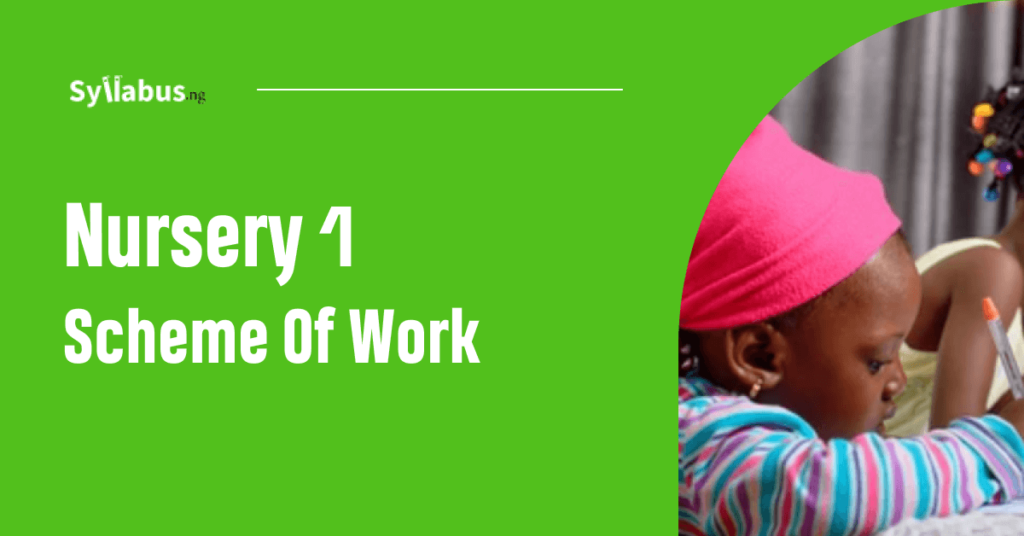 Nursery 1 Scheme of Work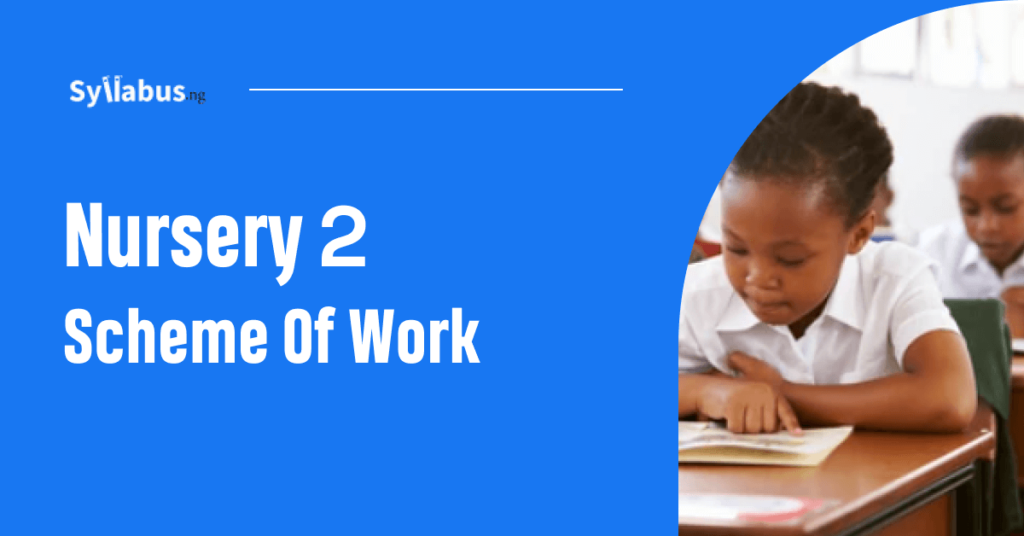 Nursery 2 Scheme of Work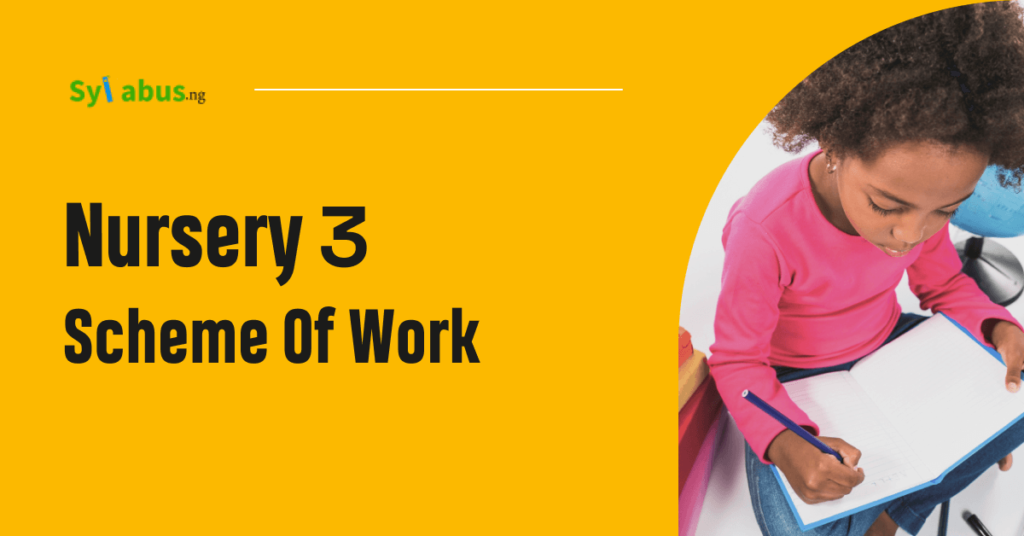 Nursery 3 Scheme of Work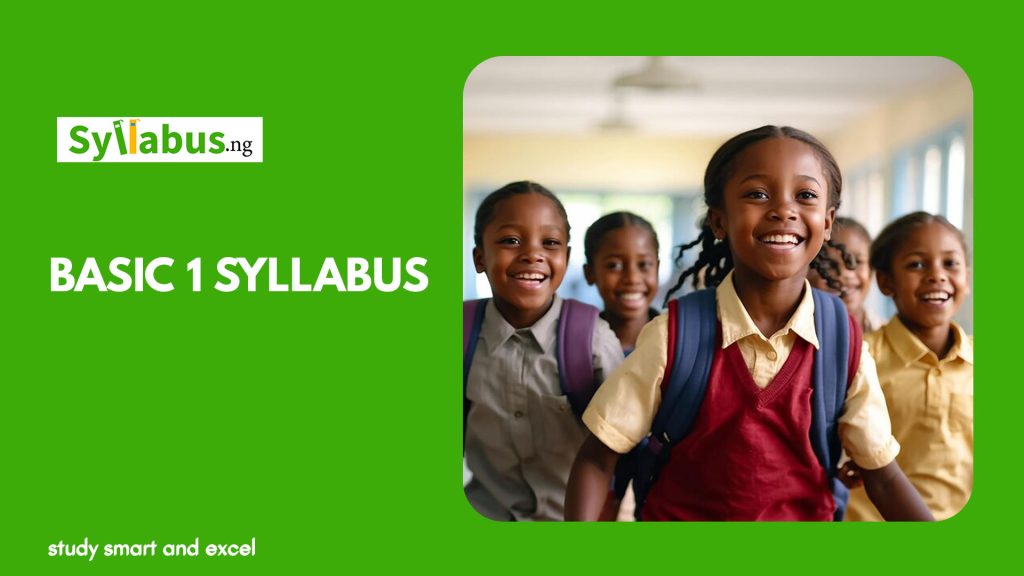 Primary 1 Scheme of WorkPrimary 2 scheme of work. 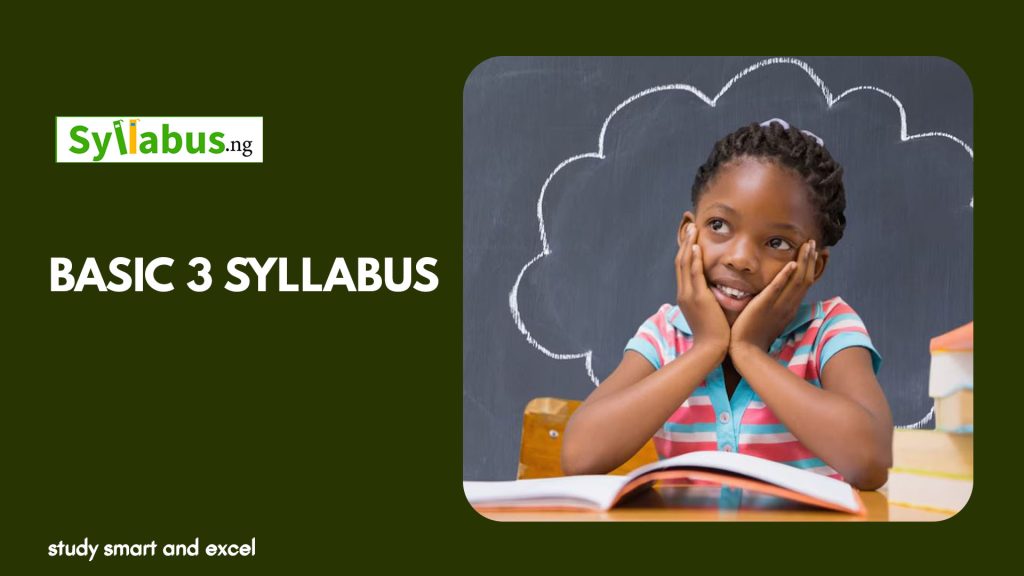 Primary 3 Scheme of Work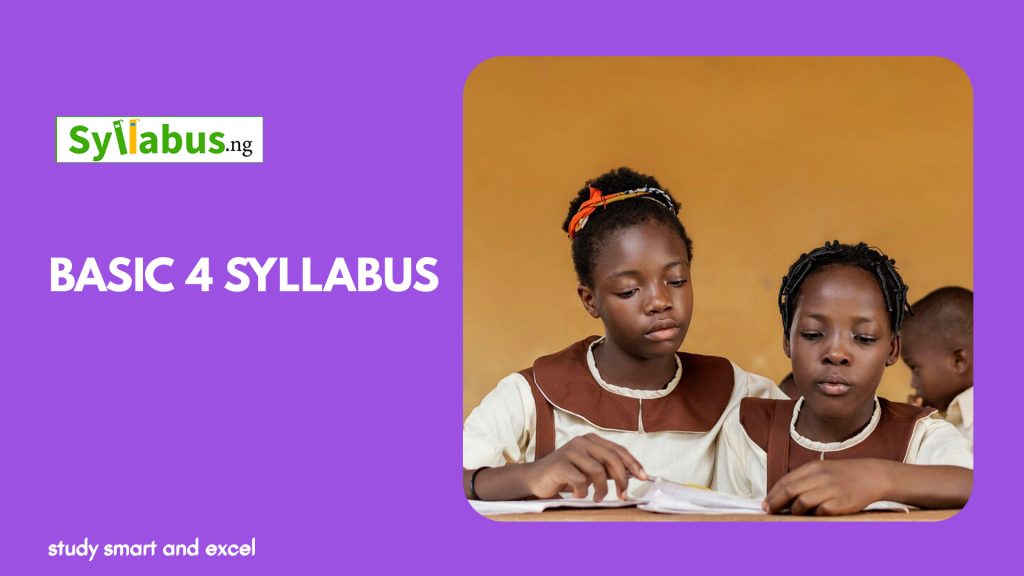 Primary 4 Scheme of Work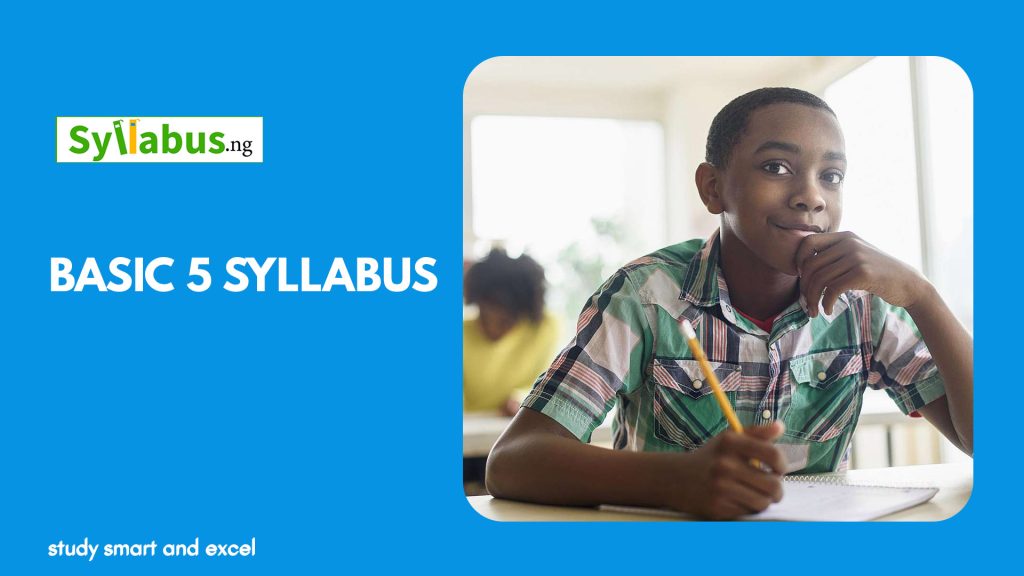 Primary 5 Scheme of Work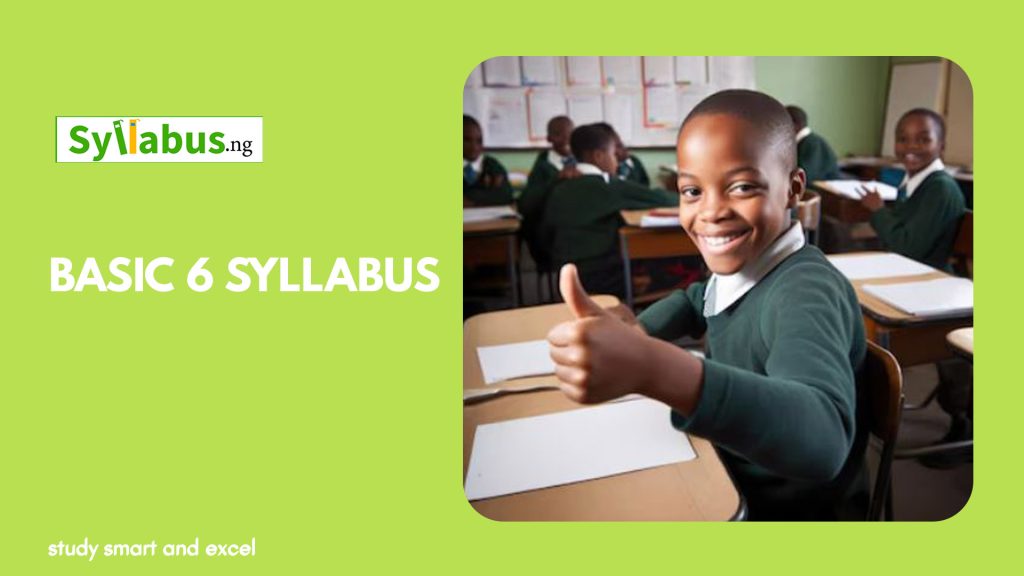 Primary 6 Scheme of WorkExam syllabus, jamb syllabus, waec syllabus, neco syllabus, jupeb syllabus, nabteb syllabus, bece syllabus, professional certification, ican syllabus, citn syllabus, trcn syllabus, cipm syllabus, scheme of work, jss1 scheme of work, jss2 scheme of work, jss3 scheme of work, sss1 scheme of work, sss2 scheme of work, sss3 scheme of work, privacy policy.  Free course > Add to basket > Checkout > Login to Course login page  Unlocking the Potential: How PE Schemes of Work Enhance Physical Education in Primary Schools Are you ready to empower young learners to lead healthy and active lives? In today's world, where physical activity is more important than ever, providing students with the tools for a well-rounded education in physical fitness, sports, and overall wellness is crucial. This is where PE schemes of work come into play. These comprehensive and innovative programs are designed to enhance physical education in primary schools, ensuring that students receive a structured and engaging curriculum that promotes lifelong health and teamwork. In this blog, we will explore the benefits of PE schemes of work and discover how they can transform physical education in primary schools. What are PE Schemes of Work?PE schemes of work are structured plans that outline the curriculum and activities for physical education in primary schools. They provide a framework for teachers to deliver effective and engaging PE lessons, ensuring students receive a well-rounded education in physical fitness, sports, and overall wellness. These schemes cover a range of areas, from developing fundamental movement skills to fostering a love for physical activity and teamwork. The flexibility of PE schemes of work allows teachers to adapt the curriculum to meet the needs and abilities of their students while also ensuring a logical progression of skills and knowledge. Additionally, they offer teachers a wealth of resources, including lesson plans, assessment tools, and equipment recommendations, which saves time and effort in lesson planning. Benefits of Using PE Schemes of Work:Implementing PE schemes of work in primary schools offers numerous advantages for both teachers and students: Structured and Coherent Curriculum: PE schemes of work provide a clear roadmap for teachers, leading to coherent and progressive lessons. This ensures that students can build upon their skills over time, resulting in better learning outcomes. Engaging and Inclusive Lessons: Designed to be inclusive, PE schemes of work cater to students' diverse needs and abilities. They offer a variety of activities and resources, enabling all students to participate and succeed, regardless of their skill level or background. Aligned with National Curriculum Standards: PE schemes of work align with national curriculum standards, ensuring consistency and quality in physical education across primary schools. Promotes Fitness and Well-Being: Focusing on developing fundamental movement skills and promoting physical fitness, PE schemes of work help students develop healthy habits and improve their overall well-being. Enhances Teamwork and Cooperation: Through activities that promote teamwork and cooperation, students learn to communicate, collaborate, and work together towards common goals. Supports Assessment and Evaluation: PE schemes of work provide assessment tools and guidelines, facilitating the evaluation of student's progress and providing constructive feedback. Research and Statistics on the Impact of PE Schemes of Work:Numerous studies highlight the positive impact of PE schemes of work on physical education in primary schools: A study by the University of Exeter reported increased student engagement and enjoyment in PE lessons in schools using PE schemes of work. Students were more motivated to participate in physical activities and showed improved attitudes towards physical education. Research published in the British Journal of Sports Medicine found that students who received regular PE lessons through a structured scheme of work were more likely to engage in physical activity outside of school and maintain healthy habits into adulthood. A survey by the National Association for Physical Education (afPE) revealed that teachers in schools with PE schemes of work reported increased confidence in delivering high-quality PE lessons that met national curriculum standards. Statistics from the Department for Education demonstrated that primary schools implementing PE schemes of work witnessed improvements in students' physical fitness levels, including cardiovascular fitness, coordination, and motor skills. Components of an Effective PE Scheme of Work:To ensure an effective PE scheme of work, the following components are essential: Clear Learning Objectives: The scheme should have clear and measurable learning objectives, providing direction for both teachers and students. Progression and Continuity: A well-designed scheme of owrk should enable students to build upon their existing skills and knowledge, ensuring a logical flow of learning experiences. Inclusive Activities: The scheme of work should encompass activities catering to students' diverse needs and abilities, promoting inclusivity. Differentiation and Adaptation: Teachers should be able to modify activities and resources to suit individual student needs, fostering an inclusive learning environment. Assessment and Feedback: A comprehensive scheme should include assessment tools and guidelines to evaluate student's progress and provide constructive feedback. Creating a PE Scheme of Work: Step-by-Step Guide:Developing a PE scheme of work may seem daunting, but with a step-by-step approach, it becomes more manageable: Review the National Curriculum: Familiarize yourself with the national curriculum requirements for physical education in primary schools. Identify Key Skills and Concepts: Determine the key skills and concepts you want to focus on in your PE scheme of work. Plan for Progression: Map out the progression of skills and concepts across each key stage. Select Activities and Resources: Choose various activities and resources that align with your learning objectives. Adapt and Differentiate: Consider your students' diverse needs and abilities and plan for differentiation and adaptation. Create a Lesson Plan Template: Develop a lesson plan template with key components such as learning objectives, activities, resources, assessment strategies, and differentiation options. Trial and Refine: Pilot your PE scheme of work with a small group of students and gather feedback. Implement and Evaluate: Once satisfied, implement the scheme with your students, monitor its effectiveness, and make necessary adjustments. Integrating PE Schemes of Work with the National Curriculum:PE schemes of work play a vital role in integrating physical education with the national curriculum. They ensure that PE lessons align with national standards and learning objectives. To achieve this integration: Align Learning Objectives: Ensure that the activities and resources in the scheme address the learning objectives specified in the national curriculum. Meet Content Expectations: Cover the required content areas specified in the national curriculum, including fundamental movement skills, various physical activities, and healthy lifestyles. Adapt to Key Stages: Tailor the scheme to meet the developmental needs of students at different key stages. Assessment and Reporting: Incorporate assessment tools and guidelines aligned with the national curriculum's requirements. Case Studies:Successful Implementation of PE Schemes of Work in Primary Schools: Several case studies demonstrate the successful implementation of PE schemes of work in primary schools: Oakwood Primary School: Increased student engagement and enjoyment in PE lessons, improved coordination, motor skills, and fitness levels. Willowbrook Academy: Enhanced student motivation, better problem-solving skills, and critical thinking abilities through cross-curricular activities. Maplewood Primary School: Improved social skills, increased confidence, and self-esteem through team sports and group activities. Evaluating and Assessing the Effectiveness of PE Schemes of Work:To ensure the effectiveness of PE schemes of work, adopt these evaluation and assessment strategies: Student Assessments: Regularly assess students' progress and achievement in physical education. Student Surveys and Feedback: Gather feedback from students about their experiences in PE lessons. Teacher Observations and Reflections: Observe teachers delivering PE lessons and provide constructive feedback. Parent and Community Feedback: Engage parents and the community in the evaluation process. Data Analysis and Comparison: Analyse data collected from assessments, surveys, and observations. Conclusion:PE schemes of work are transformative tools that unlock the potential of physical education in primary schools. Their structured and comprehensive approach promotes students' fitness, teamwork, and overall well-being. The positive impact of PE schemes of work is supported by research and real-world case studies, making them indispensable in today's education landscape. By following the step-by-step guide, integrating the scheme with the national curriculum, and continuously evaluating its effectiveness, schools can ensure that their PE programs empower young learners to lead healthy, active, and fulfilling lives. Let's join hands and make physical education a way of life for the next generation!  No comments 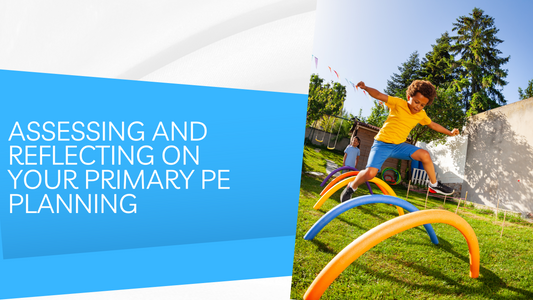 Assessing and Reflecting on Your Primary PE Planning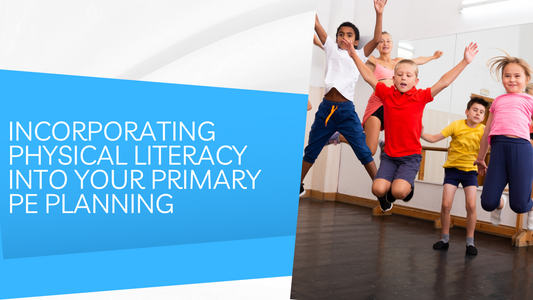 Incorporating Physical Literacy into Primary PE Planning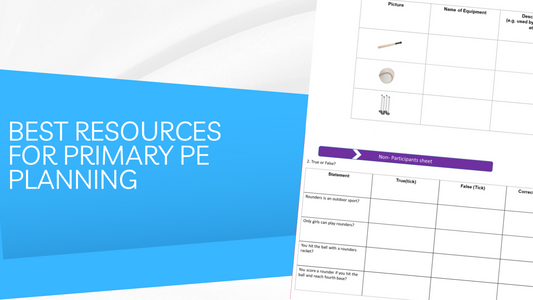 Best Resources for Primary PE Planning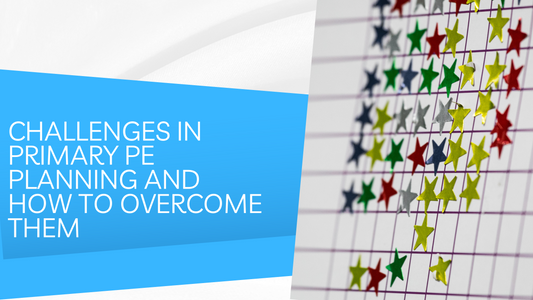 Challenges in Primary PE Planning and How to Overcome ThemEmail have already subscribed! - Choosing a selection results in a full page refresh.
ClassRoomNotesHoliday week 4 – start 19th july and end 19th sept, 2024. First Term Lessons Notes | First Term Exam Questions | How I spent my Last Holiday | Approved Y2024 – Y2025 Harmonized Academic Calendar Lagos State Pdf Free Download | Join Us @080WhatsApp | 080 Telegram and WhatsApp Channel Second Term Physical and Health Education (PHE) Plan Lesson Notes According to the the Lagos State Scheme of Work for Primary 4 (Basic 4) Lesson NotesPHYSICAL AND HEALTH EDUCATION SECOND TERM PLAN LESSON NOTES ACCORDING TO THE LAGOS STATE SCHEME OF WORK FOR PRIMARY 4 (BASIC 4) WEEKS/CONTENT LINKS WEEK 1 – Importance of Community Efforts for Health Promotion WEEK 2 – Community Efforts for Health Promotion WEEK 3 – Meaning and Types of Waste Disposal WEEK 4 – Meaning of Physical Fitness Exercise WEEK 5 – Performing Physical Fitness Exercises WEEK 6 – Importance of Physical Fitness WEEK 7 – Basic Movements in Gymnastic I WEEK 8 – Basic Movements in Gymnastic II WEEK 9 – Basic Movements in Gymnastic with Apparatus WEEK 10 – Meaning and Importance of Food Nutrition WEEK 11 – Nutritional deficiency and Diseases WEEK 12 – Safety at Home (to and fro school) SECOND TERM EXAMINATION – Second Term Examination Physical and Health Education Basic 4 DOWNLOAD – Basic Science and Technology (BST) – New Lagos State Unified Scheme of Work for Primary 4 – 6 2021 Edition NEXT TERM Third Term Physical and Health Education Plan Lesson Notes for Primary 4 (Basic 4) PREVIOUS TERM First Term Physical and Health Education Plan Lesson Notes for Primary 4 (Basic 4) Related Posts System Applications – Meaning and Types of System Applications Primary 3/Basic 3 Term 2 Week 2 Information Technology/Computer StudiesUses and importance of water (primary 1). 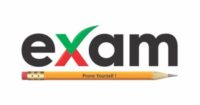 Second Term examination Basic Science Basic 8 (JSS 2) – Exam QuestionsAbout the author.  Alabi M. S.Welcome! We believe teachers inspire our future. CRN (ClassRoomNotes) is a website FOR TEACHERS BY TEACHERS, and we aim to continuously inform and encourage teaching! All materials are subject to TERMLY review. Your email address will not be published. Required fields are marked * Email Address: * Save my name, email, and website in this browser for the next time I comment. This site uses Akismet to reduce spam. Learn how your comment data is processed . primary two physical and health education scheme of work  FIRST TERM PHYSICAL AND HEALTH EDUCATION SCHEME OF WORK FOR PRIMARY TWO (2)Lagos State Scheme of Work for Physical and Health Education, First Term Physical and Health Education Curriculum - Edudelight.com Scheme… Privacy OverviewSchemeofWork.Com Access Scheme of work, Curriculum for Primary and Scondary Schools  Geography Scheme of Work SSS3 Lagos State Geography Scheme of Work SSS2 Lagos State Geography Scheme of Work SSS1 Radio,Television and Electronics Works Scheme of Work SSS3Radio,television and electronics works scheme of work sss2. - Schemes of Work
- Privacy Policy
Physical and Health Education PHE Scheme of Work JSS2 Lagos State Physical and Health Education for Junior Secondary Schools in Nigeria. JSS2 PHE Scheme of Work – Schemeofwork JSS 2 PHYSICAL AND HEALTH EDUCATION FIRST TERMSubject: BST (PHE) TOPIC: Revision /Welcome Test Learning Objectives: Students should be able to: 1. Revises the last term work on Athletics (Track and Field Events). 2. Summarizes the last term work on Ball Games e.g (Volleyball and Soccer). Learning Activities: 1. Students in pairs analyze Track and Field event. 2. Students in small group demonstrate different skills in Volleyball and Soccer at each station until the whole task is executed. Embedded Core Skills: 1. Digital Literacy. 2. Collaboration & Communication. 3. Student Leadership & Personal Development. 4. Critical Thinking & Problem Solving Learning Resources: Video Resource: https://www.youtube.com/watch?v=nSS_qd_10GE https://www.youtube.com/watch?v=xoi6bqVYDzg https://www.youtube.com/watch?v=0mVGn-ZIavQ https://www.youtube.com/watch?v=nwT_aryIP3Y Website Resource: https://www.slideshare.net/mobile/CaseyBanugan/track-and-field-events-63697116 https://www.slideshare.net/mobile/Juanigarciacervigon/ppt-athletics https://www.slideshare.net/cbpilar/volleyball-60244420 Instructional Materials: 1. Video clips 2. Flash Card 3. Poster TOPIC: 1. Explain the concept of recreation and Leisure. 2. Classify the types of recreational activities. 3. Distinguish between indoor and outdoor activities with examples. (Indoor: Ludo, Watching film show, Playing music, sewing etc. Outdoor: Camping, Excursion, Football, Tennis etc) 1. Students as a class will discuss recreation and leisure. 2. Students in pairs will classify the type of recreational activities. 3. Students in small group differentiate between indoor and outdoor activities. 4. Students in group demonstrate recreational activities such as table tennis, ludo and soccer. 1. Collaboration & Communication. 2. Student Leadership & Personal Development. 3. Digital Literacy. 4. Critical Thinking & Problem Solving. 5. Creativity & imagination. Video Resource: https://www.youtube.com/watch?v=YkeIkmzYSz4 https://forestrypedia.com/recreation-and-recreation-management-concept-need-and-importance/ https://www.slideshare.net/anasomoray/recreation-leisure Dance and RhythmLearning Objectives: Students should be able to: 1. Explain the concept of Dance and Rhythm. 2. Classify the types of Dance with examples. 3. Deduce the values of Dance / Rhythmic activities. 1. Students as a class discuss the concept of Dance and Rhythm. 2. Students in pairs classify the type of Dance with examples. 3. Students in group analyze the values of Dance / Rhythmic activities. 1. Collaboration & Communication. 3. Creativity & Imagination. 4. Digital Literacy 5. Critical Thinking & Problem Solving. https://www.youtube.com/watch?v=Hdl7myUxXSI https://www.youtube.com/watch?v=IIphUpa0vko https://www.youtube.com/watch?v=Cw-tHBLMr4U https://www.youtube.com/watch?v=MlImgiky-sQ https://www.youtube.com/watch?v=1zVHq2Gzuu8 https://www.youtube.com/watch?v=syM-CDe5Rzc https://www.youtube.com/watch?v=uiGgYgXXhHM https://www.britannica.com/art/dance https://en.m.wikipedia.org/wiki/Dance https://www.slideshare.net/mobile/dgurlwholovesherlyf/introduction-to-dance-78217448 Different Dance Costumes 1. Demonstrate different dancing steps in Atilogwu. 2. Dramatize different dancing steps in Bata. 3. Perform different dancing steps in Pokiti. 1. Students in small group demonstrate different dancing step in Atilogwu 2. Students in group dramatize different dancing steps in Bata. 3. Students in small group perform different dancing steps in Pokiti. Embedded Core Skills: 3. Digital Literacy https://www.youtube.com/watch?v=s6UYat3YLI8 4. Different Dance Costumes 1. Explain First Aid 2. Classify the objectives of First Aid. 3. Discover the qualities of a First Aider. 4. Show the content of a First Aid box and uses. 5. Determine the basic principles of First Aid. 1. Students as a class discuss the concept of First Aid. 2. Students in pairs classify the objectives of First Aid. 3. Students in small group identify the qualities of a First Aider. 4. Students in group identify the content of a First Aid box. 5. Students as a class determine the principles of First Aid. CLASS PROJECT Students in small groups construct a first box with the use of a cardboard, shoe box 4. Critical Thinking. 5. Creativity & Imagination. https://www.youtube.com/watch?v=SKxQr49LV0Y https://www.youtube.com/watch?v=gn6xt1ca8A0 http://www.gputtawar.edu.in/downloads/first-aid.pdf https://www.cartercenter.org/resources/pdfs/health/ephti/library/lecture_notes/health_extension_trainees/LN_HEW_First_Aid_Mgmt_final.pdf 4. First Aid box 5. Charts Safety Education 1. Compare the concept of Safety, Safety Education, and Accident. 2. Differentiate the Classification of Accident. (Home/Domestic, School, Transportation and Workplace). 3. Investigate the causes and prevention of Accident. (Home/Domestic, School, Transportation and Workplace). 4. Recommend the safety measure to be taken. 1. Students as a class discuss the concept of Safety, Safety Education, and Accident. 2. Students in small group differentiate the classification of Accident. (Home/Domestic, School, Transportation and Workplace). 3. Students in group investigate the causes and prevention of Accident. 4. Students as a class recommend the safety measure to be taken. 5. Creativity & Imagination. https://www.youtube.com/watch?v=yeOXSOQhwto https://www.youtube.com/watch?v=dBf6BTX1bmM https://www.youtube.com/watch?v=fcv1BxCL3Z8 https://classhall.com/lesson/safety-safety-education-accidents/ https://www.parkerlawfirm.com/library/common-ways-children-are-injured-in-school-accidents.cfm 4. Charts TOPIC: CONTINUOUS ASSESSMEN/MID TERM BREAK Subject: BST (PHE) Sport InjuriesLearning Objectives: 1. Analyze sports injuries. 2. Distinguish the common sports injuries. (Wound, Dislocation, Sprain, Strain, Fracture, Muscle fatigue, Muscle cramp, etc.). 3. Assess the common sports injuries under the following heading (causes, symptom, and treatment) 1. Students as a class analyze sports injuries. 2. Students in group discuss common sports injuries. 3. Students as a class discuss the causes, symptom, and treatment. 4. Creativity & Imagination. https://www.youtube.com/watch?v=OcGeUdfL-s4 https://www.youtube.com/watch?v=BZMD3cfyjVI Field Event1. Identify the equipment used for Throws and Jumps Events. 2. Construct the sectors of throw events. 3. Dramatize the basic phases in throws events (Javelin, Shot-put, and Discus) 4. Demonstrate the basic phases in Jumps events (High jump, Long jump) 5. Appraise the General rules & regulations of various throws and jumps event. 1. Students in pairs identify the equipment used for Throws and Jumps Events. 2. Students as a class construct the sectors of Throws events. 3. Students in small group dramatize the basic phases in throws events (Javelin, Shotput, and Discus). 4. Students in group demonstrate the basic phases in Jumps events (High jump, Long jump). 5. Students as a class appraise the general rules ®ulations of various Throws and Jumps event. Video Resource: https://www.youtube.com/watch?v=0JqdQsZqvnc https://www.myactivesg.com/Sports/Athletics/How-To-Play/Athletics-Facts/What-are-field-events-in-athletics http://www.sportspectator.com/fancentral/track/guide03.html https://www.topendsports.com/sport/athletics/events.htm https://www.dlgsc.wa.gov.au/sport-and-recreation/sports-dimensions-guide/athletics-throwing-events https://sout.org/general-rules-field-events/ https://www.sportsrec.com/5870696/list-of-events-in-track-field 4. Diagrams 5. Javelin 6. Shotput 7. Discus 8. Upright /Crossbar Learning Objectives : 1. Write brief history on Judo. 2. Classify the type of facilities and equipment used in Judo. 3. Demonstrate the basic skills and techniques in Judo. 4. Examine the rules and regulations in Judo. 5. Identify the Officials in Judo. 1. Student as a class discuss the history of Judo. 2. Students in pairs classify the type of facilities and equipment used in Judo. 3. Students in small group demonstrate the basic skills and techniques in Judo. 4. Students in group examine the rules and regulations in Judo. 5. Students as a class identify the officials in Judo. 1. Collaboration & Communication. 5. Critical Thinking & Problem Solving. https://www.youtube.com/watch?v=Zy7bRVk5hP0 https://www.youtube.com/watch?v=UrjPLuNtMy0 https://www.vmanc.com/a-brief-history-of-judo/ https://sport-wiki.org/sports/judo/ https://www.slideshare.net/AfeefaMusthafa/judo-skills-and-techniques https://www.rulesofsport.com/sports/judo.html https://www.theukrules.co.uk/rules/sport/judo/index.html TOPIC: REVISION TOPIC: EXAMINATIONS PHYSICAL AND HEALTH EDUCATION- PHE SCHEME OF WORK JSS2 SECOND TERMSUBJECT: BST (PHE) TOPIC: Revision (Welcome Test) LEARNING OBJECTIVES: By the end of the lesson, students should be able to: 1. Revises the last term work on Recreation and Dance. 2. Summarizes the last term work on First Aid, Safety Education, and Sports Injury. 3. Revises the last term work on Field event and Judo. LEARNING ACTIVITIES: 1. Students as a class discuss the concept of recreation and dance. 2. Students in small group summarize First Aid, Safety Education, and Sports Injury. 3. Students in group engage Field event and Judo. EMBEDDED CORE SKILLS: 2. Student Leadership &Personal Development. LEARNING RESOURCES: https://www.scribd.com/document/434793043/Module-1-doc https://www.google.com/url?sa=t&source=web&rct=j&url=http://www.gputtawar.edu.in/downloads/first- EVALUATION: Table TennisBy the end of the lesson, students should be able to: 1. Write brief history on Table Tennis 2. Analyze the skills used in Table Tennis 3. Categorize the type of equipment used in Table Tennis. 1. Student as a class discuss the brief history of Table Tennis. 2. Students in pairs analyze the skills used in Table Tennis. 3. Students as a class categorize the type of equipment used in Table Tennis. https://www.youtube.com/watch?v=24HKRrWRUMg https://www.youtube.com/watch?v=1BgAcGWShOk https://www.youtube.com/watch?v=9JuY98nrvLA https://www.britannica.com/sports/table-tennis https://www.tutorialspoint.com/table_tennis/table_tennis_tutorial.pdf https://www.liberty.edu/media/1211/rules/IMS-Table-Tennis-Rules.pdf https://en.m.wikipedia.org/wiki/Table_tennis 4. Racket 6. Ball 7. Table Tennis board Practical Demonstration 1. Design a Table Tennis board. 2. Examine the basic rules and regulations in Table Tennis. 3. Identify the Officials in Table Tennis 4. Demonstrate the skills in Table Tennis (e.g. Service, Grip, Footwork, Backhand stroke/drive, Forehand stroke/drive, and Smash etc.). 1. Students in group design a Table Tennis board with sightseeing from other groups. 2. Students as a class examine the basic rules and regulations in Table Tennis. 3. Students in pairs identify the Officials in Table Tennis. 4. Students in group demonstrate the skills in Table Tennis. 1. Write brief history on Tennis 2. Categorize the Facilities and equipment used in Tennis. 3. Demonstrate the skills and techniques in Tennis. 4. Appraise the rules and regulations in Tennis. 5. Identify the officials and their duties in Tennis. 1. Students as a class discuss brief history on Tennis. 2. Students in pair’s categories the facilities and equipment used in Tennis. 3. Students in group demonstrate the skills and techniques in Tennis. 4. Students in small group examine the rules and regulations in Tennis. 5. Students as a class identify the official and their duties in Tennis. 4. Creativity & Imagination https://www.youtube.com/watch?v=znbpWMuORa4 https://www.youtube.com/watch?v=hQ2ETdwn4-w https://www.youtube.com/watch?v=WYdr2Dc3Z98 https://www.lths.net/cms/lib/IL01904810/Centricity/domain/165/units/Tennis.pdf https://en.m.wikipedia.org/wiki/Tennis https://www.slideshare.net/ysowryareddy/tennisnew 6. Tennis Ball 7. Canvass Tennis1. Demonstrate the skills in Tennis (e.g. Service, Grip, Footwork, Stance, Backhand stroke/drive, Forehand stroke/drive, volley, and Smash etc.). 1. Students in group demonstrate the skills in Tennis. 1. Collaboration & Communication. 1. Student Leadership &Personal Development. 2. Digital Literacy 7. Canvas School and Community Health1. Explain School Health programmer. 2. Classify the objectives of School Health programmer. 1. Students as a class discuss School Health programmer 2. Students in small group classify the objectives of School Health programmer. 4. Critical Thinking & Problem Solving . https://www.youtube.com/watch?v=QDXeq5S_J8A https://www.youtube.com/watch?v=AQL3TFqIBrk https://www.legit.ng/1116069-school-health-programme-nigeria.html http://www.ashaweb.org/about/what-is-school-health/ https://www.slideshare.net/ShivrajDandgi/school-health-services-14665433 https://www.slideshare.net/sameekshabhardwaj1/school-health-services-85767276 http://unesco.org.pk/education/documents/publications/School%20Health%20Programme.pdf TOPIC: CONTINUOUS ASSESSMENT/MID TERM BREAK School and Community HealthAnalyses the components of school health programmer Students in small groups exhibit the components of school health programmed 4. Critical Thinking &Problem Solving. Environmental Pollution1. Write short note on Environmental Pollution. 2. Categorize the types of Environmental Pollution. 1. Students as a class discuss Environmental Pollution. 2. Students in small group categorize the types of Environmental Pollution. https://www.youtube.com/watch?v=L5B-JMnBIyQ https://www.youtube.com/watch?v=OqHp03RRTDs https://www.slideshare.net/mobile/waseemkhanpbn/environmental-pollution-and-its-types https://www.researchgate.net/publication/327779390_Environmental_Pollution_and_Its_Control https://www.interesjournals.org/articles/environmental-pollution-and-sustainability.pdf 1. Determine the sources and causes of environmental pollution. 2. Investigate the effects of environmental pollution. 3. Recommend the preventive measures on environmental pollution. 1. Students in small group determine the sources and causes of Environmental Pollution. 2. Students in group investigate the effects of Environmental Pollution. 3. Students as a class recommend the preventive measures on Environmental Pollution. TOPIC: R EVISION TOPIC: EXAMINATIONS JSS 2 PHYSICAL AND HEALTH EDUCATION THIRD TERM1. Revises the last term work on Table Tennis, and Tennis. 2. Summarizes the last term work on School and Community Health, and Environmental Pollution. 1. Students in small group demonstrate skills and techniques in Table Tennis and Tennis. 2. Students in group summarize School & Community Health and Environmental Pollution. 5. Pictures Non-Communicable Diseases and their Prevention1. Explain Non-Communicable Disease. 2. Categorize the examples of non-communicable disease (E.g., Epilepsy, Asthma, Sickle cell, Obesity, Kwashiorkor). 3. Determine the causes of non-communicable disease. 4. Classify the types of non-communicable diseases. 5. Recommend the ways of preventing non-communicable diseases. 1. Student as a class explain Non-Communicable Disease. 2. Student in pairs categorize the examples of non-communicable disease. 3. Students in pairs determine the causes of non-communicable disease. 4. Students in small group classify the types of non-communicable diseases. 5. Students as a class recommend the ways of preventing non-communicable diseases. https://www.youtube.com/watch?v=fK1_SH3X2ek https://www.youtube.com/watch?v=uGHwpg-fJvc https://www.healthline.com/health/non-communicable-diseases-list#list-of-noncommunicable-diseases https://oxfordmedicine.com/view/10.1093/med/9780199661756.001.0001/med-9780199661756-chapter-237 Posture and Postural Defects1. Distinguish between Posture and postural defects. 2. Deduce the characteristics of good posture. 3. Prescribe the causes of postural defects e.g. Heredity, Habit, Diseases, accident etc. 1. Students in pairs distinguish between Posture and Postural defects. 2. Students in small group deduce the characteristic of good Posture. 3. Students as a class prescribe the causes of Postural defects. https://www.youtube.com/watch?v=OyK0oE5rwFY https://www.youtube.com/watch?v=GGeLFDbPbn0 https://www.medicinenet.com/script/main/art.asp?articlekey=9731 https://www.physio-pedia.com/Posture https://www.slideshare.net/mobile/shimaa2022/posture-1Posture https://www.edokita.com/common-postural-defects-types-causes-and-remedies/ 1. Write on postural defects e.g. scoliosis, kyphosis, flat foot, lordships, k-leg, bowleg etc. 2. Discover the effects of poor posture on the body. 3. Recommend the ways of maintaining good posture. 1. Students in group design Postural defect with its features for sightseeing to other groups. 2. Students in small group discover the effects of poor Posture on the body. 3. Students as a class recommend the ways of maintaining good posture. 5. Creativity & Imagination https://www.slideshare.net/mobile/shimaa2022/posture-15743459 Sports and Society1. Distinguish between Sports and Society. 2. Appraise the Functions and Values of Sports in the Society. 3. Design the ways sports can be used to control youth’s restiveness. 1. Students in pairs distinguish between Sports and Society. 2. Students in small group appraise the functions and values of Sports in the Society. 3. Students as a class discuss the ways sports can be used to control youth’s restiveness. https://www.youtube.com/watch?v=3gzVin8b7Ac https://www.youtube.com/watch?v=xw2X9LpNnXs https://dictionary.cambridge.org/dictionary/english/sport https://www.sciencedaily.com/terms/sport.htm https://dictionary.cambridge.org/dictionary/english/society http://studylecturenotes.com/what-is-society-meaning-and-definition-of-society/ https://bleacherreport.com/articles/2347988-12-ways-sports-make-a-positiveimpact https://blog.perfectmind.com/the-many-benefits-of-youth-sports-in-your-community https://www.eacs.wa.edu.au/2017/06/7-benefits-participating-sport/ Issues and Challenges in Physical and Health Education (Human Trafficking)1. Write on Human Trafficking. 2. Categorize the examples of human trafficking. 3. Determine the Causes of Human trafficking. 1. Student as a class discuss Human Trafficking. 2. Students in pairs categorize the examples of Human Trafficking. 3. Students in group determine the causes of Human Trafficking. https://www.youtube.com/watch?v=X05nsp2gDAs https://www.youtube.com/watch?v=35uM5VMrZas https://www.youtube.com/watch?v=yx5sWQuxu-8 https://www.youtube.com/watch?v=MRVPgQn3SdU https://www.iom.int/jahia/webdav/site/myjahiasite/shared/shared/mainsite/microsites/IDM/workshops/Health_and_Migration_09110604/related%20docs/background.pdf https://www.humanrightscareers.com/issues/10-causes-of-human-trafficking/ 4. Pictures Human Trafficking1. Discover the Health implications of human trafficking. 2. Recommend the solutions to human trafficking 1. Students in small group design health implications of human trafficking for sightseeing to other group each. 2. Students as a class recommend the solutions to human trafficking. https://borgenproject.org/top-10-solutions-to-human-trafficking/ Sports Laws1. Write on the concept of Sports Law. 2. Distinguish between Tort, Negligence, and Legal Liability. 3. Examine various Assaults in Sports. 1. Students as a class discuss the concept of sports law. 2. Students in small group distinguish between Tort, Negligence, and Legal Liability. 3. Students as a class examine various Assaults in Sport. https://www.youtube.com/watch?v=S0ZQqTJouJo https://www.youtube.com/watch?v=aP_dkMT4pWU https://legal-dictionary.thefreedictionary.com/sports+law https://www.justipedia.com/definition/5305/sports-law https://courses.lumenlearning.com/wmopen-introbusiness/chapter/tort-law-liability-and-damages/ https://courses.lumenlearning.com/suny-monroe-law101/chapter/general-law-of-torts/ http://www.leoisaac.com/law/law016.htm https://www.molawyers.com.au/news-events/news/assault-on-sporting-field-not-fair-game Ball Game (Basketball)1. Explain the nature of the game in Basketball. 2. Categorize the facilities and equipment in Basketball. 3. Design and label a standard Basketball Court. 4. Demonstrate the basic skills in Basketball. 5. Appraise the rules and regulations in Basketball Game. 1. Students as a class explain the nature of the game in Basketball. 2. Students in pairs categorize the facilities and equipment in Basketball. 3. Students in group design and label a standard Basketball Court. 4. Students in small group demonstrate the basic skills in Basketball. 5. Students as a class discuss the rules and regulations in Basketball game. https://www.youtube.com/watch?v=HKIg8_jVs1E https://study.com/academy/lesson/basketball-skills-activities-safety.html https://www.breakthroughbasketball.com/fundamentals/ballhandling.html https://www.youtube.com/watch?v=QaYwcS00vSA https://slideplayer.com/slide/7732010/ https://www.slideshare.net/vidyarai92/basketball-history-and-rules 2. The Basketball 3. The Stop Watch 4. The Whistle 5. The Score sheet/board 6. The Basketball rule Book. 7. Hand Bell. Field Trip to National Agency for the Prohibition of Traffic in Persons (NAPTIP)Explain mode of Human Trafficking through their visit to the nearest NAPTIP office. 1. Students in pairs analyze mode of Human trafficking base on their observation WEEK: 12-13 ACHIEVEMENT STANDARDS FOR BST (PHE)At the end of the session, students are able to; - Understand the difference between indoor and outdoor activities in recreation.
- Perform& classify the types of dance with examples.
- Identify the content of first aid box with their uses and its application to common sports injuries.
- Classify the causes of accident and their prevention.
- Perform the basic phases in throws (Javelin, Shot-put, and Discus) and Jumps (High jump, Long jump).
- Demonstrate the basic skills & techniques in Judo.
- Perform the skills & techniques in Table Tennis and Tennis.
- Understand the components of school Health Programmer.
- Understand the types, causes, effects and preventive measures on Environmental Pollution.
- Identify the examples, causes, and ways of preventing Non-Communicable Diseases.
- Describe the causes and types of Postural Defect.
- Understand the ways sports can be used to control youth’s restiveness.
- Identify the examples, causes, Health implication and solutions to Human Trafficking.
- Understand the difference between Tort, Negligence and Legal Liability.
- Demonstrate the basic skills & techniques in Basketball.
Leave a Reply Cancel replyYour email address will not be published. Required fields are marked * Save my name, email, and website in this browser for the next time I comment. Search for Curriculum and Scheme of workNursery scheme of work lagos state, food and nutrition scheme of work for nursery classes lagos state (3 – 5 years).  Basic Science and Technology Scheme of Work for Kindergarten Lagos State (Age 5) Number Work Scheme of Work for Nursery 1 Lagos State Civic Education Scheme of Work for Kindergarten Lagos State (Age 5)Science and mathematics scheme of work, agricultural science scheme of work sss 3 lagos state.  Further Mathematics Scheme of Work SSS 1 Lagos State Health Education Scheme of Work SSS3 Lagos State Agricultural Science Scheme of Work SSS 2 Lagos StateNursery scheme of work federal.  Nursery Scheme of Work Federal (Ages 4 – 5 Years) Pre-Primary Scheme of Work FederalNursery 2 scheme of work federal (age 5), nursery 1 scheme of work federal (age 4). Sign in to your account Username or Email Address Remember Me  | 


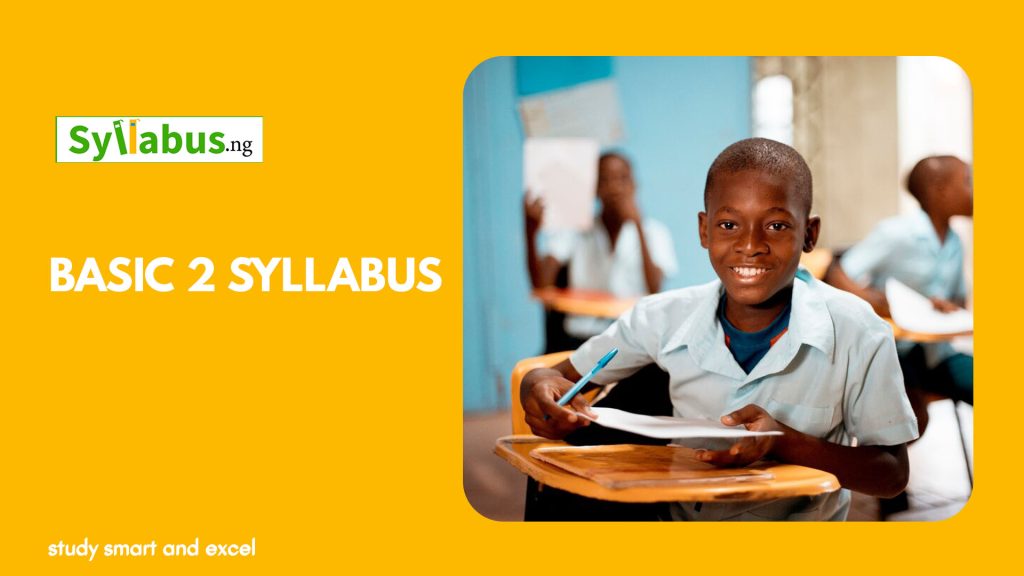
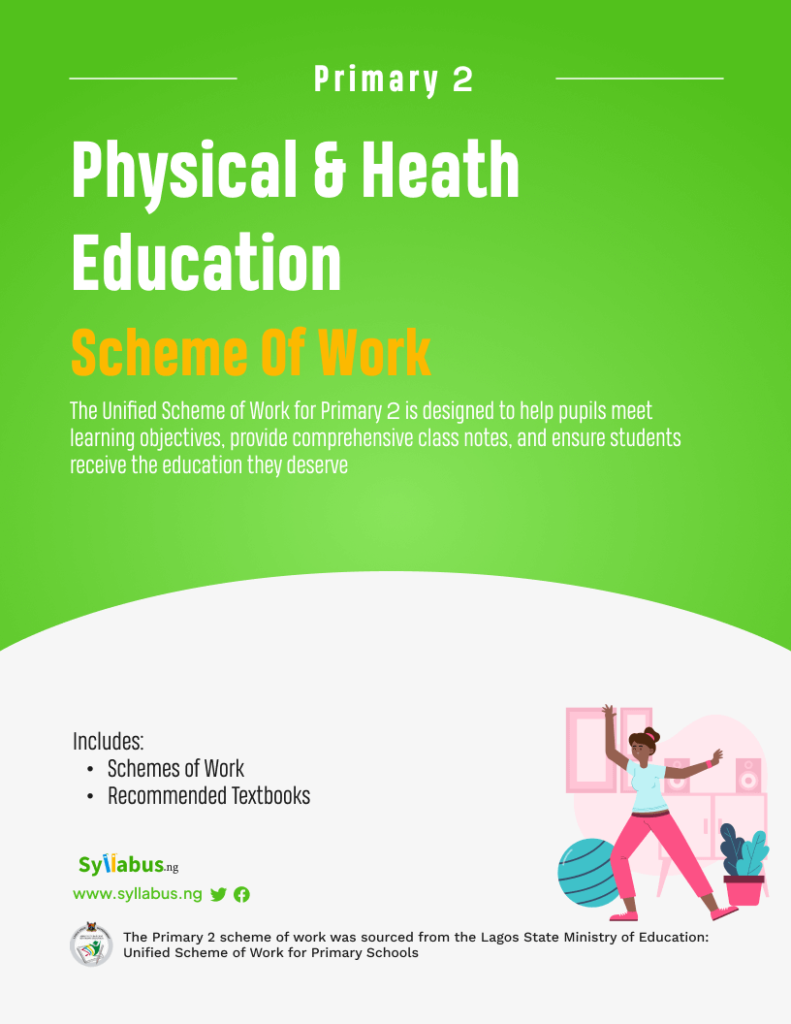































COMMENTS
Physical and Health Education Curriculum Primary 2 Scheme of Work Team Share 7 Min Read SHARE Level 2 NERDC PHE - Physical and Health Education Curriculum Primary 2 - Moving our body parts, Basket Ball, Swimming - Schemeofwork.com Table of Contents
Lagos State Schemes of Work for Primary Schools. Primary 2 Scheme of Work on Physical and Health Education. Pry 2 PHE - Schemeofwork.com
Physical and Health Education Curriculum Primary 1. THEME 1: BASIC MOVEMENTS. Week 1. Topic: MOVING OUR BODY PARTS. Performance objectives. Demonstrate correct movement patterns of leaping, walking, stepping, hopping and running, etc. Perform basic manipulative movements. Identify safety rules in walking, running, pushing and kicking etc.
Download the Primary 2 unified scheme of work for Physical Health Education as a guide for educators for the first, second, and third terms.
Lagos State Ministry of Education Syllabus for Physical and Health Education. Third Term Physical and Health Education Curriculum - Edudelight.com. WEEK 1. TOPIC: Health and hygiene. PERFORMANCE OBJECTIVE: pupils should be able to: 1.Define hygiene 2.Enumerate some ways of purifying water. 3.Describe some method of purifying water.
Telegram Line. Our Help Line (234) 08084486557. About Us. Edudelight.com gives you access to Lesson plan, Lesson notes, Scheme of work, Exam Questions, Test Questions in all subject, topics for Primary School and Secondary School.
First Term, Second Term and Third Term Physical and Health Education (PHE) Plan Lesson Notes According to the the Lagos State Scheme of Work for Primary 2 (Basic 2) Lesson Notes
1. Listen to teacher's explanation. 2. Observe teacher's demonstration. 3. Practice the basic skills taught e.g. bending and stretching.
Though, the brief content is for the Primary Two Second Term Physical and Health Education (PHE) Scheme of Work. However, it is important to state that the
This physical education lesson plan includes a presentation, lesson plan, a set of differentiated cards, aims posters and more. It's the perfect resource for your physical and health education scheme of work for primary 2. You can teach children key skills when it comes to throwing and catching a ball. We also have this fantastic Football ...
PHYSICAL AND HEALTH EDUCATION THIRD TERM PLAN LESSON NOTES ACCORDING TO THE THE LAGOS STATE SCHEME OF WORK FOR PRIMARY 2 (BASIC 2)
A well-designed scheme of work forms the backbone of a successful primary PE curriculum. By carefully considering the aims, objectives, learning outcomes, progression, assessment strategies, and inclusion principles, teachers can create an engaging lesson. Best Practices and Tips for Creating Effective Lesson Plans Primary Physical Education.
Are you ready to empower young learners to lead healthy and active lives? In today's world, where physical activity is more important than ever, providing students with the tools for a well-rounded education in physical fitness, sports, and overall wellness is crucial. This is where PE schemes of work come into play. These comprehensive and innovative programs are designed to enhance physical ...
BST: Physical and Health Education for Primary School. PHE Scheme of Work Pry 5/Basic 5.Field events - Schemeofwork.com
10. 11/112. . 2 SECOND TERM PHYSICAL AND HEALTH EDUCATION SCH. OF WORKTOPIC The striking games (table t. nis and lawn tennis) Basic skills and tec. ques of table tennis Equipment and. ilities of table tennis Rules and reg. ation of table tennis Officials of. ble tennis and their duties Basic.
Edudelight.com gives you access to Lesson plan, Lesson notes, Scheme of work, Exam Questions, Test Questions in all subject, topics for Primary School and Secondary School.
Lagos state Scheme of work. 2nd Term physical and Health Education Scheme of work - Edudelight.com Curriculum. THEME: PHYSICAL AND HEALTH EDUCATION. SUB- THEME: BASIC MOVEMENT. WEEK 1. TOPIC: Non locomotor movement. PERFORMANCE OBJECTIVE: Pupils should be able to: 1. demonstrates the non locomotor movements. 2. list examples of non locomotor.
WEEK 11 - Nutritional deficiency and Diseases WEEK 12 -Safety at Home (to and fro school) SECOND TERM EXAMINATION - Second Term Examination Physical and Health Education Basic 4 DOWNLOAD - Basic Science and Technology (BST) - New Lagos State Unified Scheme of Work for Primary 4 - 6 2021 Edition
Lagos State Scheme of Work primary School Download Federal Scheme of Work for Secondary School Federal Scheme of Work for Primary School Lesson Note for Primary School Download (First, Second and Third Term) Nursery Scheme of work- (Nursery 1, 2, 3) Phonics and English Diction Scheme from Pre nursery, Nursery and Primary school
Physical and Health Education (PHE) ELesson note for Secondary School - Edudelight.com. SCHEME OF WORKPHYSICAL AND HEALTH EDUCATIONJ. S. S. 2 SECOND TERM. WEEKS TOPICS. 1. i. The striking games (table tennis and lawn tennis) ii.
Non communicable diseases, Posture and postural defect, Sport and the society, Sport law. Health Education Lesson Note JSS2 Third Term - Edudelight.com
Physical and Health Education for Junior Secondary Schools in Nigeria. JSS2 PHE Scheme of Work -Schemeofwork